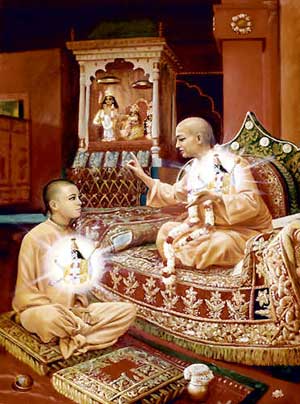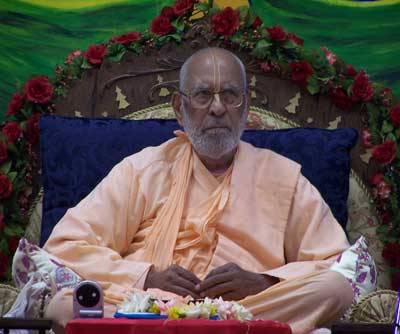Sri Srimad Bhaktivedanta Narayana Gosvami Maharaja
Alachua, Florida: April 29, 2008
I offer my heartly obeisances unto the lotus feet of my spiritual master, param-aradhyatama (most worshipful) nitya-lila pravista om visnupada Sri Srimad Bhakti Prajnana Kesava Gosvami Maharaja, and the same obeisances unto the lotus feet of my siksa-guru, nitya-lila pravista om visnupada Srila Bhaktivedanta Swami Maharaja.
I am very happy that there are so many devotees here in Alachua. My blessings to the organizers. They have really done a splendid thing. They have called so many devotees from many various places to come here – both senior and junior devotees.
Perhaps you know why I have come here. In the last days of my siksa-guru’s (Srila Bhaktivedanta Swami Maharaja) manifest presence in this world, he called me and I went to his bedside. He wanted me to sit on his bed, but I offered my obeisances and sat on a separate chair. He then took my hands in his and said, “I have collected so many devotees from all over the whole world.” Then, in Bengali, so that Tamal-Krsna Maharaja and others would not understand, he said, “I have brought so many monkeys.” He was very tricky.
Srila Swami Maharaja said, “First, I request you to help them; only you can help them. Secondly, you should arrange my samadhi with your own hands.” There were so many senior god-brothers in Vrndavana, like Bon Maharaja, and his senior sannyasis like Tamal Krsna Maharaja and others; so why did he ask me to give him samadhi? He did so because he considered that there is a transcendental relationship between him and me. He had previously written this in a letter to me: “I have a transcendental relationship with you – the same relationship that my Prabhupada (Srila Bhaktisiddhanta Sarasvati Thakura) has with me.”
Therefore, to fulfill his desires, I am traveling all over the world. In my travels, I see that after his departure so many senior devotees, including sannyasis, became married. Brahmacaris also returned to home-life and married. Seniors became bewildered and weak.
It is for this reason that he has sent me, and I am seeing a good response. So many of his senior disciples are coming, and I am very happy to help them. Especially, I am very happy that there are so many of his senior disciples here in Alachua. The new devotees who are coming to me are also reading his books; it is by his inspiration that they are coming to me.
During my Western tours up until now, I have given discourses on the pastimes of Sri Krsna. I have also spoken on the stages of bhakti and the gradations of devotees. I have discussed the sweet pastimes of Krsna from the first Canto up until the tenth Canto, and I have also discussed the eleventh Canto.
Now, I want that you will hear some glories of Sri Caitanya Mahaprabhu – without which you cannot understand Srimad-Bhagavatam. If you know the sweet pastimes of Sri Caitanya Mahaprabhu – why He came and what activities He performed – then you will actually understand Srimad-Bhagavatam. You will understand who is Krsna, who is Srimati Radhika, what is Vrndavana, and so on. If camphor and sugar is added in milk, this greatly increases the taste. Sri Caitanya Mahaprabhu’s pastimes are like sweet condensed milk and sugar, and Sri Krsna’s pastimes are like camphor. This has been explained by Srila Krsnadasa Kaviraja.
[“The pastimes of Sri Caitanya Mahaprabhu are like condensed milk, and the pastimes of Lord Krsna are like camphor. When one mixes these, they taste very sweet. By the mercy of the pure devotees, whoever tastes them can understand the depths of that sweetness.” (Cc. Madhya-lila 25.278)]
[“The activities of Sri Caitanya Mahaprabhu are like condensed milk, and the activities of Ramananda Raya are like large quantities of sugar candy. Their meeting is exactly like a mixture of condensed milk and sugar candy. When they talk of the pastimes of Radha and Krsna, camphor is added. One who tastes this combined preparation is most fortunate.” (Madhya 8.304-5)]
In Alachua we will try to discuss the reasons for Sri Caitanya Mahaprabhu coming to this world. We will discuss His birth and His pastimes with Sri Nityananda Prabhu. We will discuss Raya Ramananda Samvad (His conversations with Sri Raya Ramananda), Sanatana-siksa (His instructions to Sri Sanatana Gosvami), and Rupa-siksa (His instructions to Sri Rupa Gosvami). We will try to cover as many topics as we can, and if we do not complete some topics here, we will continue in Badger.
We cannot know Sri Krsna, and especially Sri Caitanya Mahaprabhu, by ourselves; nor can we can we know everything about them by reading.
“yaha, bhagavata pada vaisnavera sthane
ekanta asraya kara caitanya-carane
[“If you want to understand Srimad-Bhagavatam, you must approach a self-realized Vaisnava and hear from him. You can do this when you have completely taken shelter of the lotus feet of Sri Caitanya Mahaprabhu.” (Sri Caitanya-caritamrta, Antya-lila, 5.131)]
The ‘box’ is there, and the ‘nectar’ is inside the box, but that nectar is ‘under lock and key.’ Similarly, we cannot understand these topics by our own endeavors. The Vaisnavas will tell you the meanings. Without a guru, no one can advance towards Sri Krsna and Sri Caitanya Mahaprabhu.
Guru-nistha (strong faith in guru) is the backbone of bhakti. Srila Rupa Gosvami said, “Visrambhena guroh seva – the disciple should see his guru as a very close friend, and serve him. Without the mercy of guru, we cannot understand or realize the transcendental truths about Krsna or Mahaprabhu.
Therefore, I want to discuss guru-tattva first. We should know the qualities of a bona fide guru; who is qualified to be a disciple; under what conditions a guru can be given up; and the result if one who does not give up a fallen guru. Today, we will discuss these points.
[Srila Narayana Maharaja called on several disciples to speak on the glories of Sri Guru as above-mentioned, and then he spoke again. After expressing his appreciation of his disciples’ presentations, he said:] Even Nityananda Prabhu – who is Baladeva Prabhu Himself – cannot complete the glorification of guru-tattva. Therefore, there is so much more to say.
Fist of all, we should consider that the glory of guru-tattva is explained throughout the Vedic scriptures:
saksad-dharitvena samasta-sastrair
uktas tatha bhavyata eva sadbhih
kinto prabhor yah priya eva tasya
vande guroh sri-caranaravindam
[“All the scriptures proclaim Sri Gurudeva is saksat hari, the direct potency of Sri Hari, and is thus considered by saintly authorities to be His non-different representative. Because Sri Gurudeva is so dear to the Lord, being His confidential servitor (acintya-bhedabheda-prakasa-vigraha, the inconceivable different and non-different worshipable manifestation of the Lord), I offer prayers unto his lotus feet.” (Sri Gurvastakam, verse 7)]
As stated in this verse, guru is saksad-dharitvena. He is non-different from God – but at the same time he is His eternal servitor.
Also:
yasya deva para bhaktir
yatha deve tatha gurau
tasyaite kathita hy arthah
prakasante mahatmanah
["Only unto those great souls who have implicit faith in both the Lord and the spiritual master are all the imports of Vedic knowledge automatically revealed." (Svetasvatara Upanisad)]
bhayam dvitiyabhinivesatah syad
isad apetasya viparyayo ’smrtih
tan-mayayato budha abhajet tam
bhaktyaikayesam guru-devatatma
[“Fear arises when a living entity misidentifies himself as the material body because of absorption in the external, illusory energy of the Lord. When the living entity thus turns away from the Supreme Lord, he also forgets his own constitutional position as a servant of the Lord. This bewildering, fearful condition is affected by the potency of illusion, called maya. Therefore, an intelligent person should engage unflinchingly in the unalloyed devotional service of the Lord, under the guidance of a bona fide spiritual master, whom he should accept as his worshipable deity and as his very life” (Srimad Bhagavatam 11.2.37)]
Do we strongly believe that guru is saksad-hari? Ask this to your heart. I think it is very rare to find a person with such faith. Maybe one or two persons believe this. Many persons are vastly learned in scriptures like Srimad-Bhagavatam, Vedanta, the Puranas, and Sri Caitanya-caritamrta, and they can repeat all the verses. So why do they disobey their Gurudeva and give him up? They should think about this:
yasya prasadad bhagavat-prasado
yasyaprasadan na gatih kuto pi
dhyayam stuvams tasya yasas tri-sandhyam
vande guroh sri caranaravindam
[“Only by the mercy of Sri Gurudeva can one receive the mercy of Krsna; without his grace the living entities cannot make any advancement nor be delivered. Meditating three times a day on the glories to Sri Gurudeva and reciting stava-stuti, I offer prayers unto his lotus feet. (Sri Guruvastakam, verse 8)]
If Gurudeva has this quality, how can a disciple disobey him? If his Gurudeva tells him, “You should be a serious brahmacari” or “You should be a first-class serious sannyasi,” and that disciple knows all scripture, how can he disobey? Where is his bhakti? Where is his guru-nistha? We should deeply consider all these facts.
Now, I want to explain that accepting only a diksa-guru will not suffice for spiritual advancement.
vande 'ham sri-guroh sri-yuta-pada-kamalam sri-gurun vaisnavams ca
sri-rupam sagrajatam saha-gana-raghunathanvitam tam sa-jivam
sadvaitam savadhutam parijana-sahitam krsna-caitanya-devam
sri-radha-krsna-padan saha-gana-lalita-sri-visakhanvitams ca
[I offer pranamas to the lotus feet of Sri Gurudeva (who includes sri diksa-guru and bhajana-siksa-guru), guru-varga (our entire disciplic succession) and all other Vaisnavas, to Sri Rupa Gosvami, his elder brother Sri Sanatana Gosvami, Sri Raghunatha Dasa Gosvami, Sri Jiva Gosvami and their associates, to Sri Advaita Prabhu, Sri Nityananda Prabhu, Sri Krsna Caitanya Mahaprabu and His associates, and to the lotus feet of Sri Radha and Krsna accompanied by Sri Lalita and Visakha and all the other sakhis.]
There are some things about which the disciple cannot openly speak his heart to his diksa-guru. This is because the disciple is in an aisvarya-mood, meaning that he respects his diksa-guru with a mood of awe and veneration.
But siksa-guru is like a brother or a friend, and we can open our hearts to him. Siksa-guru must be taken, but that siksa-guru should be in the line of our diksa-guru (svajatiya snigdha asraya – he should be affectionate to us and more advanced than us. He should be an ocean of the transcendental moods for which we aspire).
Sri Caitanya-caritamrta, Adi-lila 1.35-37 states:
mantra-guru ara yata siksa-guru-gana
taìhara carana age kariye vandana
[“I first offer my respectful obeisances at the lotus feet of my initiating spiritual master and all my instructing spiritual masters.”]
sri-rupa, sanatana, bhatta-raghunatha
sri-jiva, gopala-bhatta, dasa-raghunatha
[“My instructing spiritual masters are Sri Rupa Gosvami, Sri Sanatana Gosvami, Sri Bhatta Raghunatha, Sri Jiva Gosvami, Sri Gopala Bhatta Gosvami and Srila Raghunatha dasa Gosvami.”]
ei chaya guru—siksa-guru ye amara
taì’-sabara pada-padme koti namaskara
[“These six are my instructing spiritual masters, and therefore I offer millions of respectful obeisances unto their lotus feet.”]
Srila Krsna dasa Kaviraja Gosvami has written: “These are my six siksa-gurus.” Why does he not mention the name of his mantra-guru? Who was his mantra-guru? This is unknown. Srila Kaviraja Gosvami accepted a guru in his householder life, but he considers that, “These six gurus (Rupa, Sanatana, etc.) are thousands upon thousands of times superior to my mantra-guru.” Someone may also consider: “My siksa-guru is Krsna. My siksa-guru is Caitanya Mahaprabhu.” * Will Krsna or Caitanya Mahaprabhu not be superior to your mantra-guru? They will certainly be superior.
cintamanir jayati somagirir gurur me
siksa-gurus ca bhagavan sikhi-pincha-maulih
yat-pada-kalpataru-pallava-sekharesu
lila-svayamvara-rasam labhate jayasrih
["All glories to Cintamani and my initiating spiritual master, Somagiri. All glories to my instructing spiritual master, the Supreme Personality of Godhead, who wears peacock feathers in His crown. Under the shade of His lotus feet, which are like desire trees, Jayasri enjoys the transcendental mellow of an eternal consort." (Caitanya Caritamrta Adi 1.57)]
Although in some cases it may be that the siksa-guru is superior to the diksa-guru, still, our diksa or mantra-guru should be worshipped first.
guru krsna-rupa hana sastrera pramane
guru-rupe krsna krpa karena bhakta-gane
[“According to the deliberate opinion of all revealed scriptures, the spiritual master is non-different from Krsna. Lord Krsna in the form of the spiritual master delivers His devotees.” (Sri Caitanya-caritamrta, Adi-lila 1.45)]
The word rupa in this verse means ‘form’.
siksa-guruke ta' jani krsnera svarupa
antaryami, bhakta-srestha,-ei dui rupa
[“One should know the instructing spiritual master to be the personality of Krsna. Lord Krsna manifests Himself as the Supersoul and as the greatest devotee of the Lord.” (Sri Caitanya-caritamrta, Adi-lila 1.45)]

The word svarupa in this verse means ‘own’ form. Sva means ‘own’.
What is the difference between ‘rupa’ and ‘svarupa’? There is no difference.
Regarding the understanding that sometimes the siksa-guru is more qualified than the diksa-guru:
You may have accepted a guru, but at that time you did not understand that he was a madhyama-adhikari (rather than an uttama-adhikari). Then, after some time you realized, “He cannot fulfill my spiritual desires and he cannot answer all my questions.” What should you do? Continue to go to him. He is a Vaisnava. There is no harm that he is not such a scholar.
sastra-yukti nahi jane drdha, sraddhavan
madhyama-adhikari' sei maha-bhagyavan
["One who has attained the intermediate stage is not very advanced in sastric knowledge, but he has firm faith in the Lord. Such a person is very fortunate to be situated on the intermediate platform." (Cc. Madhya 22.67)]
You may ask him, “Prabhu, may I go to this self realized person? He knows so many spiritual truths and can help me in my bhakti.” The guru will become very happy and say, “You must go.” For example, Syamananda Prabhu was a disciple of Srila Hrdaya-Caitanya in Kalna, Srila Narottama dasa Thakura was a disciple of Sri Lokanatha Gosvami, and Srinivasa Acarya was a disciple of Srila Gopala Bhatta Gosvami. By the order of their gurus, these three disciples went to Srila Jiva Gosvami. Lokanath Gosvami knew everything, but he could not express the philosophy as Srila Jiva Gosvami could.
Srinivasa Acarya’s guru, Srila Gopala Bhatta Gosvami, was always engaged in devotional service and he knew so many spiritual truths, but he happily ordered Srinivas to learn from Srila Jiva Gosvami. These three devotees always respected Srila Jiva Gosvami like their guru – or more than their guru. So, we must have a siksa-guru.
The brahmana Dattatreya had 24 gurus. There may be so many gurus [Dattatreya learned different things from the mountain, the trees, the air, the wasp, the spider, the bee, and so on], but there should be one high-class siksa-guru. We must accept at least one siksa-guru who is in the line of our Gurudeva.
There may be truly senior devotees in the line of Sri Guru. A disciple can associate with them and, as he becomes more advanced in bhakti, he will be able to realize the position of our Gosvamis and Sri Caitanya Mahaprabhu as his siksa-gurus.
We serve the siksa-guru the same as we do our diksa-guru, and then all the scriptures will be revealed in our heart. The siksa-guru follows the same line of siksa (teaching) that our Gurudeva teaches. We serve with our heart and soul the particular Vaisnava who teaches and nourishes our bhakti. There is no harm even if he is less qualified than our diksa-guru, as long as he is in the same mood.
Also, the bona fide diksa-guru is siksa-guru for all, because by his instructions and harikatha he is teaching his initiated disciples, his many followers, as well as the entire world.
Always ‘take your life in your hands’ in order to serve your Gurudeva, as Kuresh served his guru Ramanujacarya and as my Gurudeva has done. My Gurudeva was prepared to give his life for Srila Bhaktisiddhanta Sarasvati Thakura. This is service to Gurudeva.
A disciple must know the innermost desire of his guru.
sri-caitanya-mano bhistam sthaptiam yena bhutale
mjsvayam rupah kada mahyam dadati sva padantikam
[“When will Sri Rupa Gosvami give me the shelter of his lotus feet? Because he understood the innermost desire of Sri Caitanya Mahaprabhu, he was able to establish His mission in this world and is very dear to the Lord.”]
If the disciple does not know the internal mood of his Gurudeva, he is not truly a disciple. Srila Rupa Gosvami became the most near and dear disciple of Sri Caitanya Mahaprabhu by knowing his guru’s internal moods. We should be like him. We should know what Gurudeva wants.
There are two kinds of service. For example, the disciple may be thinking, “I am feeling somewhat cold, so my Gurudeva (or the Deity of Krsna), must also be feeling cold; I must give him a quilt.” Or, “I feel thirsty so I should offer him water,” or “I like such and such things so I should offer that.” But it may be that Krsna and Gurudeva do not actually like those things.
Suppose your guru has come from far away and is thirsty. You are fanning him, thinking, “Oh Gurudeva, we will wash your feet and do arati.” Gurudeva says, “Bring water.” You reply, “Let me do all these things first.” Without doing this first, how can I give you water?”
A disciple should understand practically what Gurudeva wants and give him what he wants. In that way, he can fulfill his Gurudeva’s desires. If Gurudeva says, “I want you to take the renounced order at once. I will give you sannyasa,” what is the duty of that disciple? If you know that your Gurudeva is non-different from Krsna himself, saksad-hari, and he will only be happy if you follow his order, then you must do this at once – otherwise you are not a disciple.
Do not try to only know the scriptures only intellectually. There are many scriptures and many examples in the scriptures, and we know them intellectually. But still we think “Oh, I will not follow this instruction.”
One example of this is the following:
In a statement spoken by Krsna’s demonic cousin-brother Duryodhana, Duryodhana told Krsna, “I know all the scriptures and I know what is one’s true duty (dharma), but I have no taste for that. I know what irreligion (adharma) is, and I have taste for that. You are the Supreme Lord. Whatever You inspire me to do, I am doing. I am not responsible for what I do; You are responsible.”
[*Endnote – The example of a devotee having Sri Krsna as siksa-guru is Sri Bilvamangala Thakura, whom Sri Krsna personally lead all the way to Vrndavana. The example of Sri Caitanya Mahaprabhu being siksa-guru is for those who are actually qualified for raga-marga (the stage of spontaneous loving devotion). As stated in Jaiva Dharma (Chapter 39, pg.839) in reference to the second verse of Sri Manah Siksa:
“On the rasa-marga, He is the exclusive object of bhajana as Sri Radha-vallabha, and He has appeared as Saci-nandana (Mahaprabhu), the sole guru of vraja-rasa. Therefore, perform bhajana of that Saci-nandana, considering Him to be guru who is very dear to Krsna (Krsna-prestha).”]
Editor: Syamarani dasi
Assistant Editors: Hariballabha dasi and Ratna dasi
Transcriber: Janaki dasi and Vasanti dasi
Typist: Anita dasi
Proof-reader: Krsna-kamini dasi
Picture of Srila Narayana Gosvami Maharaja courtesy of: Krsnamayi dasi
Painting copyright Bhaktivedanta Book Trust International, Inc.









